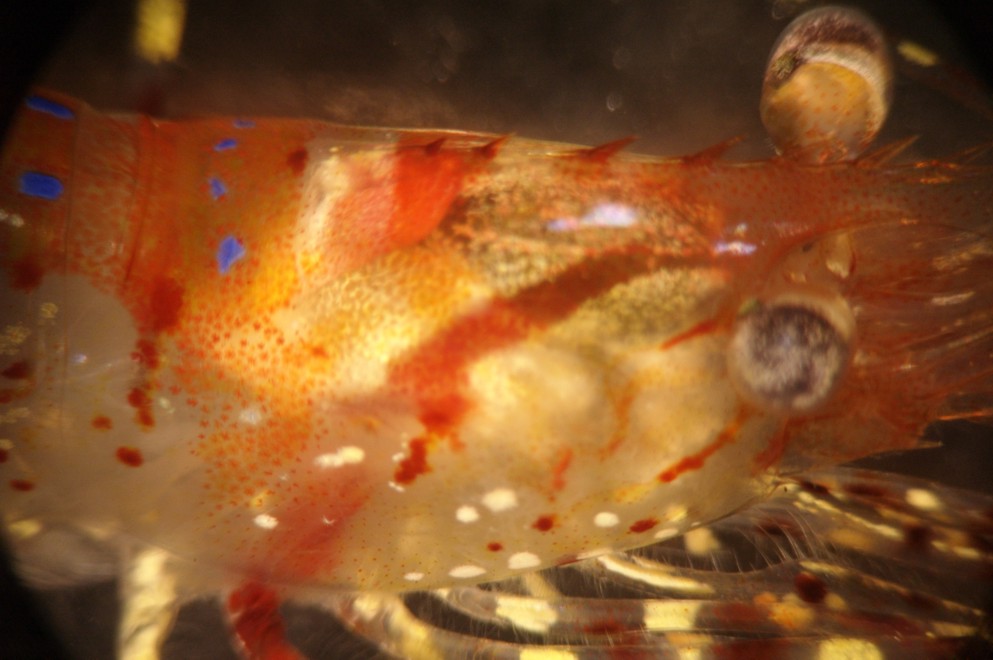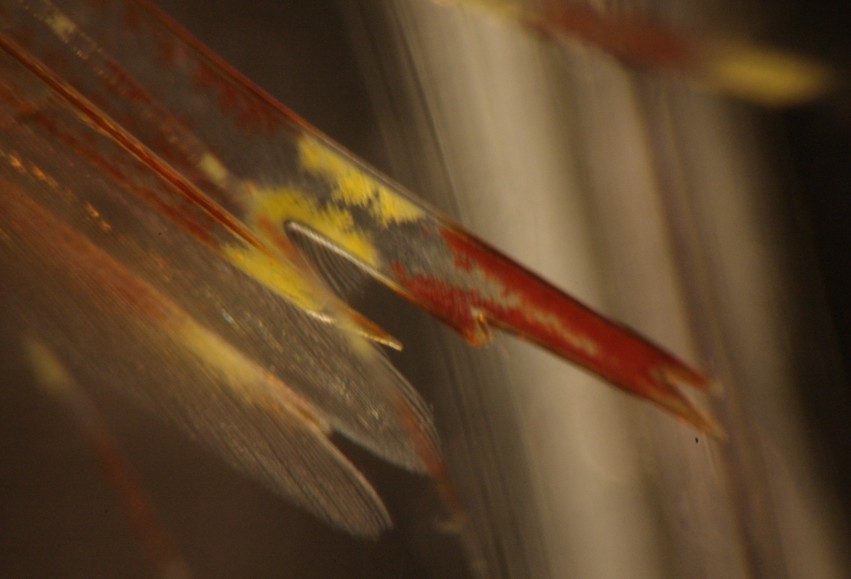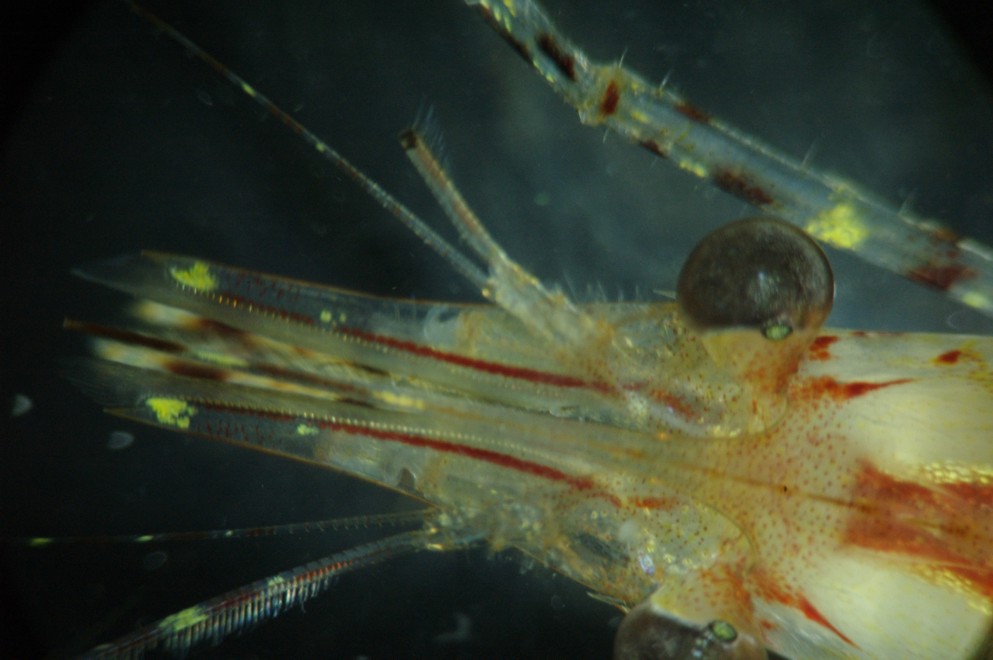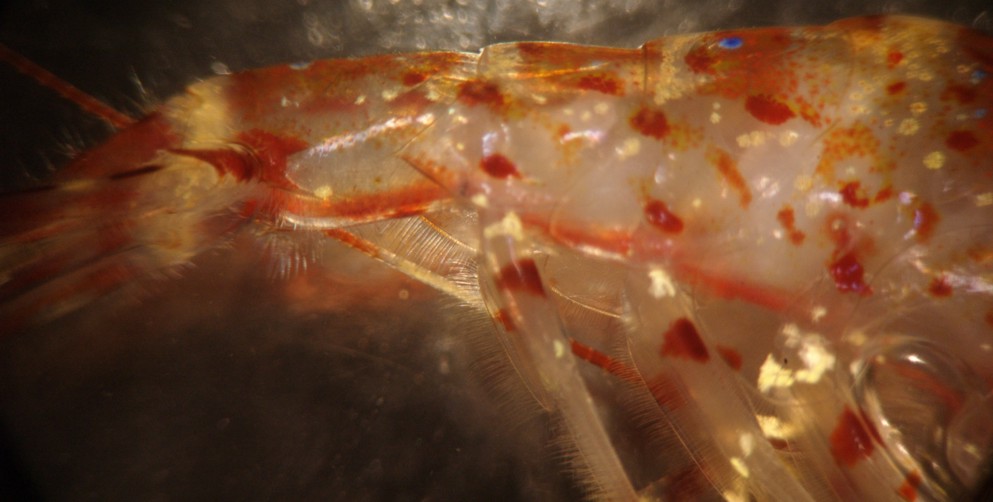Pandalus stenolepis Rathbun, 1902Common name(s): Rough patch shrimp |
|
| Synonyms: | 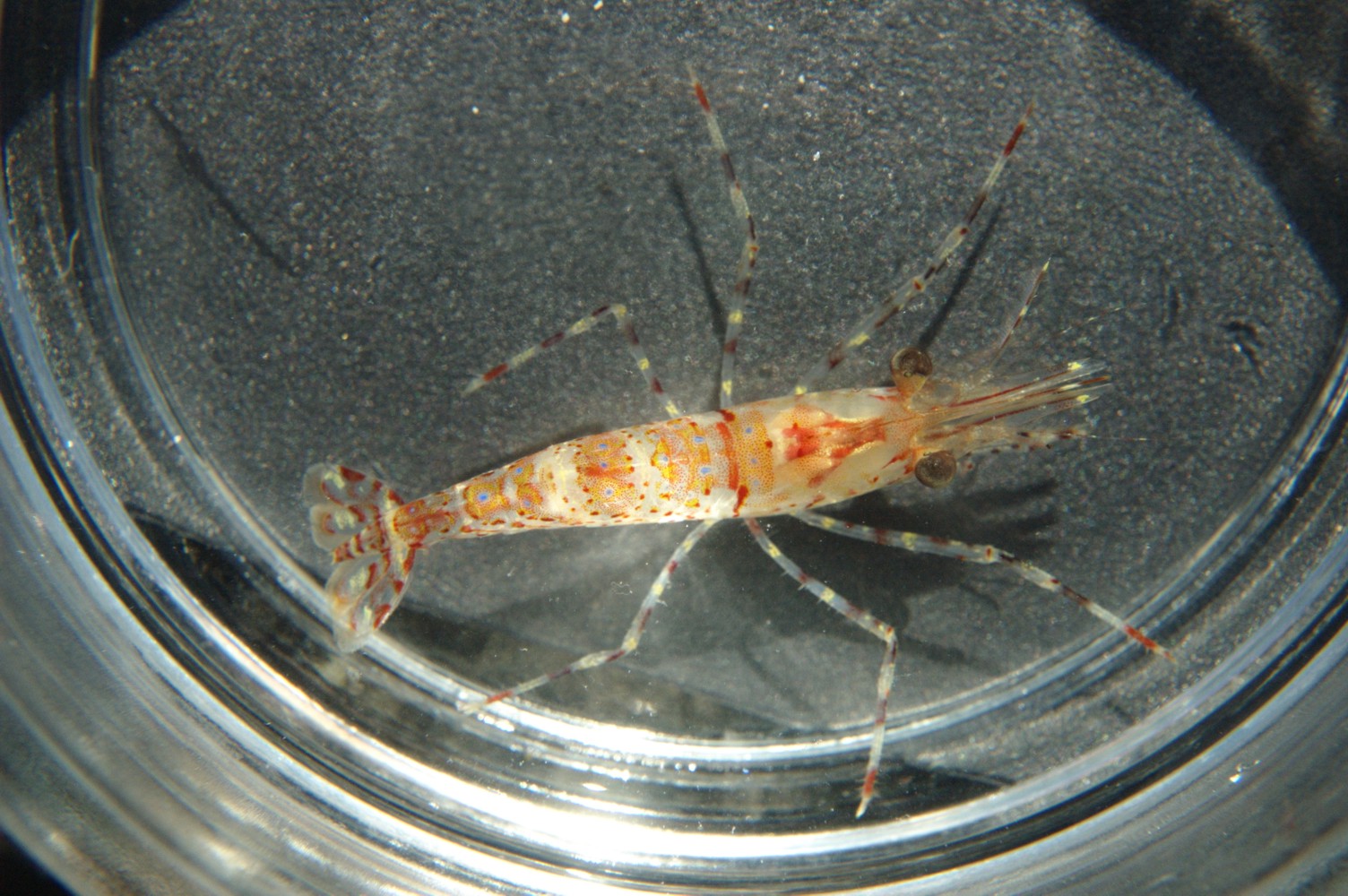 |
|
Phylum Arthropoda
Subphylum Crustacea
Class Malacostraca
Subclass Eumalacostraca
Superorder Eucarida
Order Decapoda
Suborder Pleocyemata
Infraorder Caridea
(true shrimp)
|
|
| Pandalus stenolepis captured at about 130 m depth in the channel between Lopez and San Juan Islands. Total length about 5.5 cm. | |
| (Photo by: Dave Cowles, August 2012) | |
Description: As with all members of Family Pandalidae, The rostrum is prominent with movable dorsal spines (photo) and the carpus of pereopod 2 is subdivided into many (more than 7) subunits (a condition known as 'multiarticulated'). This species has antenna 1 only about as long as the carapace. Abdominal segment 3 has no median dorsal ridge and no posterior spine (photo). The median dorsal spines on the carapace extend to behind the midpoint of the carapace (photo), but there are only 8-12 such spines, including those on the dorsal rostrum. These spines have a red patch at their base (photo). The rostrum is 1.2-1.4x the length of the rest of the carapace, and the distal 2/3 ascend sharply. There are 5-7 spines on the underside of the rostrum and the rostral tip is bifid (photo). There is a rough patch on the cardiac region (upper rear sides) of the carapace. The telson has 3-5 pairs of small dorsolateral spines (photo). The pink antennal scale has a concave outer margin (photo) and the distal half of the blade is narrower than the adjacent axis. Coloration: Carapace: Patches of red dots along sides, band of closely spaced dots along the anterolateral margin to the base of the rostrum. At least one large yellow dot on lower sides and two blue dots high on each side near the back, behind the pubescent or rough patch (photo). Abdomen: Sides with patches of red dots on dorsal and upper lateral surfaces of 1st and 3rd segments + on lower pleura and bases of pleopods (photo). Yellow dots and patches on lower anterior part of first segment and on lower part of second pleuron. Blue spots on segments 1, 2, 3, 4 (photo) (plus my observation--they are also found dorsally on abdominal segments 5,6). Males carapace length to 14.4 mm (76 mm total length), females to 18.2 mm carapace length, 82 mm total length.
How to Distinguish from Similar Species: This species is smaller than most other Pandalids. It is most similar to Pandalus danae but has red spots instead of diagonal stripes on the sides of the abdomen and the blue spots are more distinct.
Geographical Range: Unalaska Island, Alaska to Hecata Bank, Oregon
Depth Range: 18-229 m
Habitat: This species is a protandric hermaphrodite.
Biology/Natural History:
The adult
of this species looks much like P.
danae, but the larvae are very distinctive.
| Return to: | |||
| Main Page | Alphabetic Index | Systematic Index | Glossary |
References:
Dichotomous Keys:Kozloff, 1987, 1996
General References:
Butler, 1980
Jensen, 1995
Lamb and Hanby, 2005
Scientific Articles:
Komai,
T., 1999. A revision of the genus Pandalus
(Crustacea: Decapoda: Caridea: Pandalidae). Journal of
Natural History
33:9 pp. 1265-1372
Needler, Alfreda Berkeley, 1938. The larval development of Pandalus stenolepis. Journal of the Fisheries Research Board of Canada 4a: 2 pp. 88-95
Rothlisberg, Peter C., 1980. A complete larval description of Pandalus jordani Rathbun (Decapoda: Pandalidae) and its relation to other members of the genus Pandalus. Crustaceana 38:1 pp. 19-48
Web sites:
General Notes and Observations: Locations, abundances, unusual behaviors:
In this side view of the carapace the dorsal spines, which extend to behind the midpoint of the carapace and have a red patch at the base, can be seen. Also visible are the blue spots over the cardiac region of the carapace and the scattering of red, white, and yellow spots. The rougher patch of the carapace is anterior to the blue spots, but is not plainly visible here. The blue spots farthest to the left are on the first abdominal segment.
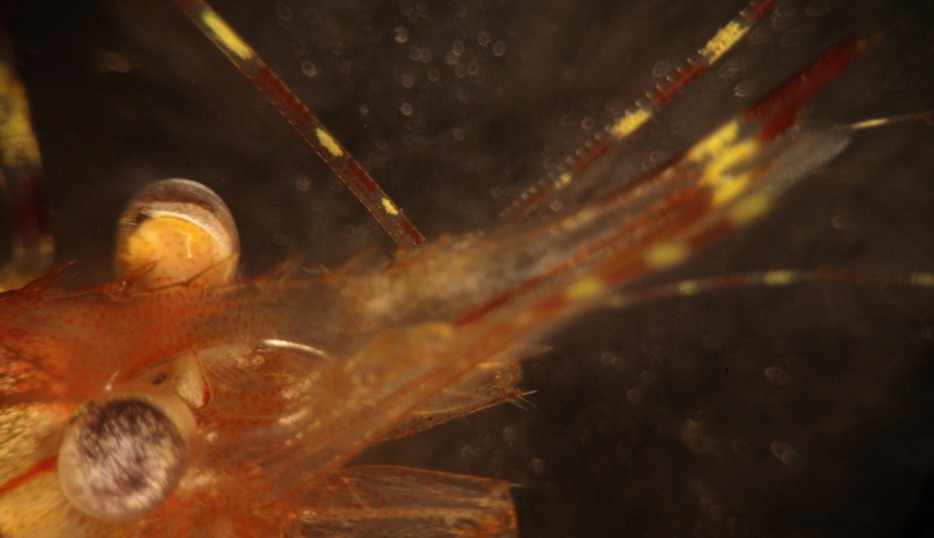
In this side view of the rostrum
the movable dorsal
spines can be seen.
The tip of the rostrum is bifid. In this view the setae lining the ends of the antennal scales can be seen below the rostrum.
This dorsal view of the anterior head shows that the antennal scale has a concave outer margin.
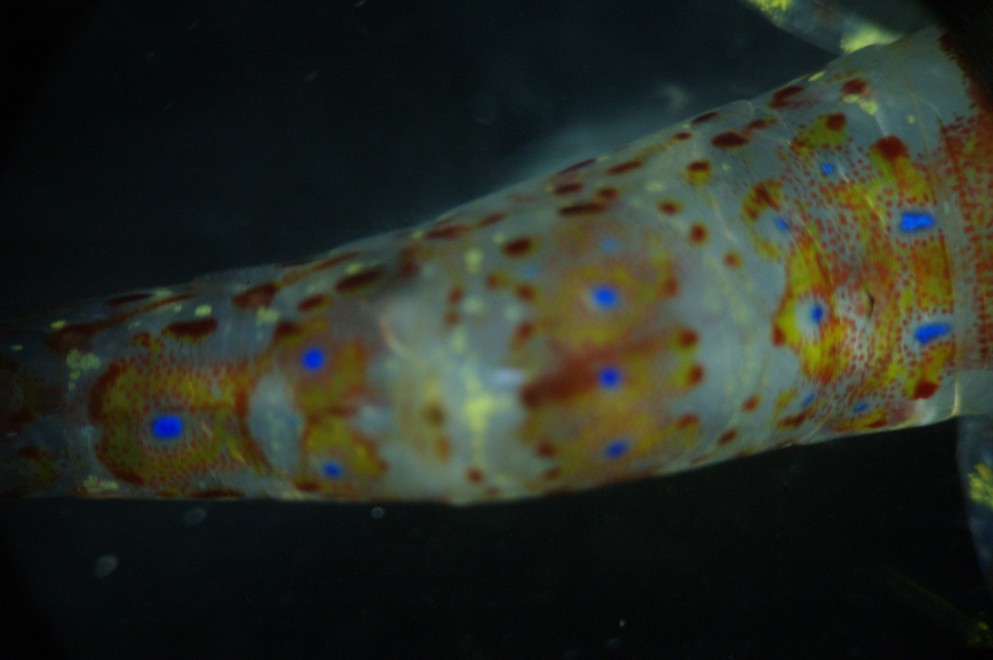
Abdominal segments 1-4 (and 5-6) have blue dots dorsally and laterally.
This side view of segments 3-6 of the abdomen show the pattern of spots plus the fact that abdominal segment 3 (far right) has no mid-dorsal carina nor a rear-projecting spine on the posterior margin. The mid-dorsal blue spot cannot be seen on segment 5 in this view (but see the previous view). Note also that the main lateral markings on the abdomen are red dots, some of which are aggregated into reddish stripes which angle upward posteriorly, as opposed to the well-defined red stripes on the sides of Pandalus danae's abdomen, which angle downward posteriorly.
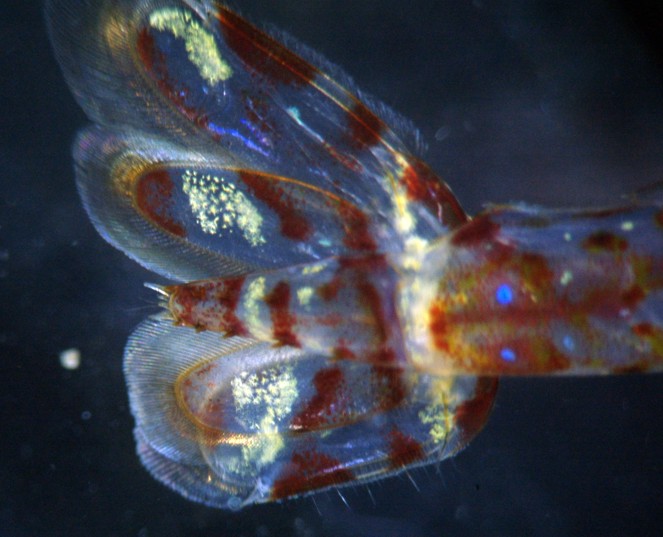
The telson
has 3-5 pairs of dorsolateral
spines.
Authors and Editors of Page:
Dave Cowles (2012): Created original page
CSS coding for page developed by Jonathan Cowles (2007)
Salish Sea Invertebrates web site provided courtesy of Walla Walla University
